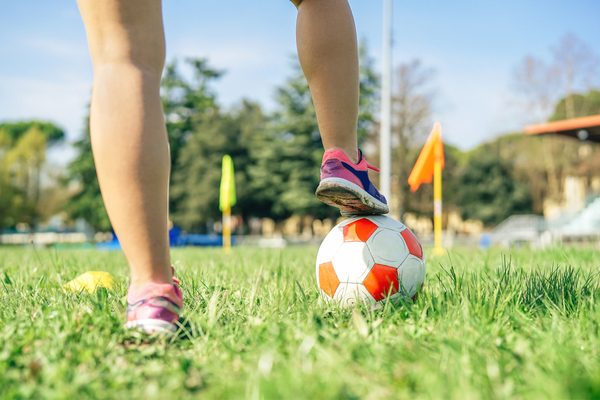Cardio, core strength, agility and a thriving social life? No wonder football is Britain’s most popular sport and offers some serious fitness goals. Here’s how to give it a go if you’re a back-of-the-net novice.
By Lizzy Dening
- You can increas your leg muscle mass by 11 per cent if you play football for two hours a week for 16 weeks, according to a study.
- 48 per cent of young women felt less self-conscious as a result of playing football.
- In a 14-week study, women who played football improved their cardio fitness by 15 per cent
With the Women’s World Cup kicking off in France today (June 7), we’ve got football on the brain. While you might have been busy with hockey or netball during your school days, miss out on footie now and you might be missing a health (hat)trick. Whatever health gains you’re looking, chances are you can find them in football. From lowering blood pressure to burning fat, football is often credited as a better overall workout than running, and that’s without factoring in the fun and potential for making new friends. If you never learnt at school, it’s easy to feel intimidated by the thought of giving it a go, but a lack of experience shouldn’t put you off.
‘Most of the women I teach have never played before, and certainly didn’t ever think they’d own a pair of football boots,’ says Mel Capleton, a former professional footballer and founder and director of Open Air Fit, a company that runs outdoor fitness classes for beginners. ‘I find it much easier to teach women than men – they tend to listen more! It’s amazing to see how quickly new recruits improve, and there’s a lot of encouragement there.’
So if you’re looking to change your body from the inside out, have a regular kick about!
Why football will boost fitness better than running
You might want to swap your running shoes for studs – football could be the best use of your time when it comes to your health. There are several science-backed ways showing it delivers more bang for your buck than running. Firstly, it turns out women benefit more from recreational footie than they do running when it comes to overall fitness – thanks to its combination of kicks, twists, turns and sprints, according to research from Copenhagen. Moving in this way uses both your slow and fast-twitch fibres, helping you to burn fat at a higher rate.
How football boosts bone health
Playing footie has been found to reduce your risk of falls and bone fractures, by improving muscle strength, postural balance, bone mineral density and your reflex response. Bone density is improved more by football than from running, as demonstrated in a study of women who had never played before, aged 20-47. They also showed improved balance and muscle strength. Even more impressively, in a study on men, elderly players were found to not only have higher bone density than their contemporaries, but also higher than younger, sedentary men.
Why football improves your heart health
Just two football sessions a week for three months created a significant reduction in blood pressure, resting pulse rate and also percentage of body fat among inactive people, according to Danish research. And it’s no wonder, when you consider how busy running up and down a pitch can keep you. ‘It contains elements of almost every type of exercise,’ says Mel. ‘There’s cardio to work your heart and lungs, HIIT drills and agility work.’
Why a game of footie burns serious calories
‘Dribbling a ball is much harder work than normal running, and because you’re concentrating you’re working hard without thinking about it. You can easily burn 400-550 calories in a 90-minute session,’ says Mel.
How a kick about helps you make new friends
It’s not only your fitness and health that will improve – your social circle might too. ‘The social element of football is really important,’ says Mel, ‘and studies have shown that if you train in a group you’re more likely to maintain your motivation.’ This was proven in a study that found that the players also had a higher degree of motivation to stick to exercising, and increased ability to make new friendships, according to the University of Copenhagen. For best results, keep your group small: five-a-side matches provided the best workout when compared to full games thanks to all players having to work hard.
Improve your fitness with our easy back garden football workout
Place five or six small cones (or any small object) out in a single file line, about a foot apart.
- Run in a slalom (looping around them, to the left of one, then the right, and so on) as fast as you can manage, for 60 seconds.
- Run with ‘quick feet’ over the top of them, as if you were stepping over a ladder and avoiding the rungs, for 60 seconds.
- Take a football and try to move the ball through the markers in a slalom, using both feet, and without touching the markets. Start by walking and try to build up speed, for 60 seconds.
- Repeat the exercises, two sets of each, trying to get faster. It sounds easy but it’s tiring, and the weaving between markers will give your core a workout.
Studies and sources for further reading:
Soccer reduces risk of falls and bone fractures
Benefit more from football over running








